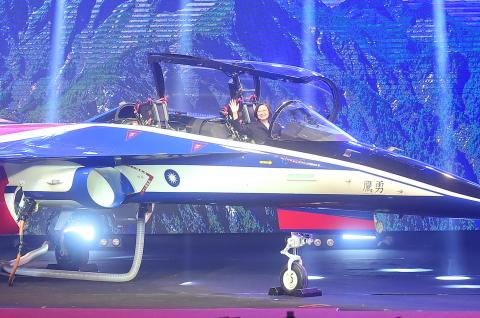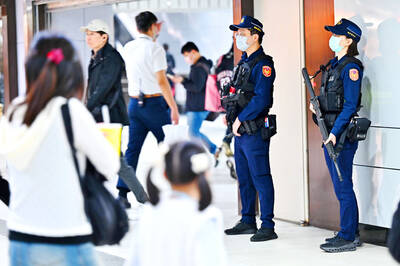President Tsai Ing-wen (蔡英文) yesterday attended the rollout of the first indigenously produced Advanced Jet Trainer at the Aerospace Industrial Development Corp (AIDC, 漢翔航空) factory in Taichung’s Salu District (沙鹿)
The manufacture of the prototype, which the Ministry of National Defense named the AIDC T-5 Yung Ying (勇鷹, “Brave Eagle”), marks a historic milestone for the air force, the nation’s aerospace industry and the administration’s pledge to create a self-sufficient defense industry, Tsai said.
“There have been many challenges, detractors, critics and naysayers on the long journey leading to this day, but the facts show that we were right and our efforts were not in vain,” she said before thanking the ministry, the AIDC and the Chungshan Institute of Science and Technology.

Photo: Liao Yao-tung, Taipei Times
Tsai said that the idea for the indigenous trainer came from a discussion in 2016 with then-AIDC chairman Feng Shih-kuan (馮世寬) when she was campaigning as the Democratic Progressive Party’s (DPP) presidential candidate.
Feng had told her that the AIDC had tried and failed to convince the then-Chinese Nationalist Party (KMT) government to develop a military jet, and that this would have grave consequences for industry in Taiwan, she said.
After becoming president, she made it a priority of her administration to support the design and manufacture of an advanced jet trainer, which also served to revive the aerospace industry, she said.
Since 2017, the trainer program has spent NT$37.7 billion (US$1.22 billion at the current exchange rate) on Taiwanese enterprises, or more than half of its NT$68.6 billion budget, and created 1,200 jobs, she said, adding that the program would create another 800 jobs by 2021.
In response to requests for comment, Institute of National Defense and Security Research senior analyst Su Tzu-yun (蘇紫雲) said that the Advanced Jet Trainer has a dual-purpose platform — both flight and tactical training — which increases air force efficiency and streamlines logistics.
The air force uses the Beechcraft T-34 for basic flight training, the AIDC AT-3 for intermediate flight training and the Northrop F-5 for advanced tactical training, he said.
The Advanced Jet Trainer would replace the AT-3 and the F-5, which the air force plans to retire, he said, adding that having a common platform for flight and tactical training would facilitate training and reduce operating costs.
The Yung Ying and the AIDC’s Indigenous Defense Fighter have interchangeable parts, so mass-producing the Advanced Jet Trainer would increase the supply of spare parts for both, he said, adding that the jets use a Honeywell/ITEC F124 engine, which is 55 percent domestically produced.
While information about the Advanced Jet Trainer’s avionics have not been made public, the jet is believed to have a glass cockpit that allows different flight characteristics to be simulated via augmented reality technology, he said.
The trainer prototype was dubbed the XAT-5, suggesting that the Advanced Jet Trainer is capable of bombing or launching missiles at ground troops, motor vehicles and ships, he said.
Producing armaments domestically is considered to increase the value of the allocations by a factor of 2.5, meaning that the trainer program should add NT$150 billion to the economy, he added.
Additional reporting by CNA

TRAGEDY STRIKES TAIPEI: The suspect died after falling off a building after he threw smoke grenades into Taipei Main Station and went on a killing spree in Zhongshan A 27-year-old suspect allegedly threw smoke grenades in Taipei Main Station and then proceeded to Zhongshan MRT Station in a random killing spree that resulted in the death of the suspect and two other civilians, and seven injured, including one in critical condition, as of press time last night. The suspect, identified as a man surnamed Chang Wen (張文), allegedly began the attack at Taipei Main Station, the Taipei Fire Department said, adding that it received a report at 5:24pm that smoke grenades had been thrown in the station. One man in his 50s was rushed to hospital after a cardiac arrest

SAFETY FIRST: Double the number of police were deployed at the Taipei Marathon, while other cities released plans to bolster public event safety Authorities across Taiwan have stepped up security measures ahead of Christmas and New Year events, following a knife and smoke bomb attack in Taipei on Friday that left four people dead and 11 injured. In a bid to prevent potential copycat incidents, police deployments have been expanded for large gatherings, transport hubs, and other crowded public spaces, according to official statements from police and city authorities. Taipei Mayor Chiang Wan-an (蔣萬安) said the city has “comprehensively raised security readiness” in crowded areas, increased police deployments with armed officers, and intensified patrols during weekends and nighttime hours. For large-scale events, security checkpoints and explosives

A car bomb killed a senior Russian general in southern Moscow yesterday morning, the latest high-profile army figure to be blown up in a blast that came just hours after Russian and Ukrainian delegates held separate talks in Miami on a plan to end the war. Kyiv has not commented on the incident, but Russian investigators said they were probing whether the blast was “linked” to “Ukrainian special forces.” The attack was similar to other assassinations of generals and pro-war figures that have either been claimed, or are widely believed to have been orchestrated, by Ukraine. Russian Lieutenant General Fanil Sarvarov, 56, head

PUBLIC SAFETY: The premier said that security would be tightened in transport hubs, while President Lai commended the public for their bravery The government is to deploy more police, including rapid response units, in crowded public areas to ensure a swift response to any threats, President William Lai (賴清德) said yesterday after a knife attack killed three people and injured 11 in Taipei the previous day. Lai made the remarks following a briefing by the National Police Agency on the progress of the investigation, saying that the attack underscored the importance of cooperation in public security between the central and local governments. The attack unfolded in the early evening on Friday around Taipei Main Station’s M7 exit and later near the Taipei MRT’s Zhongshan